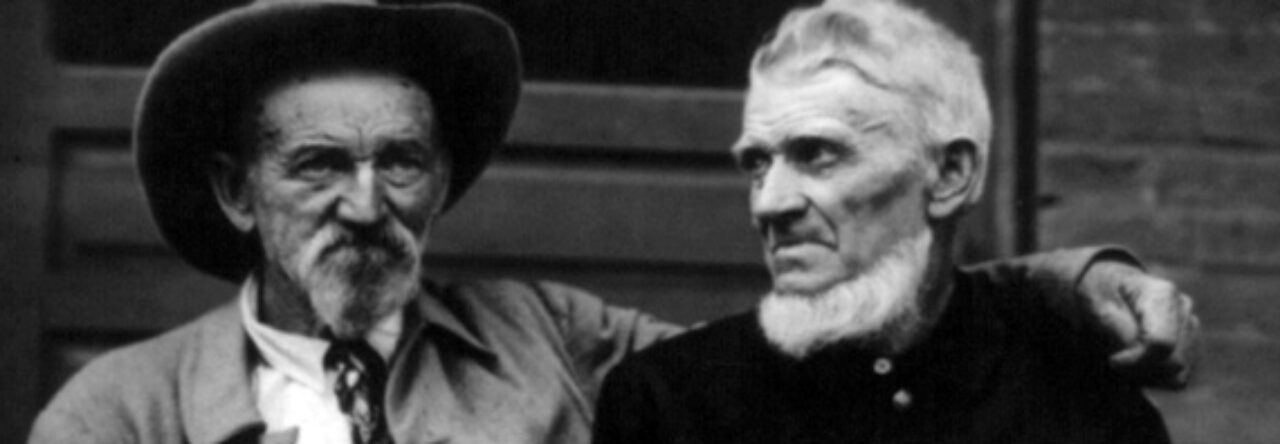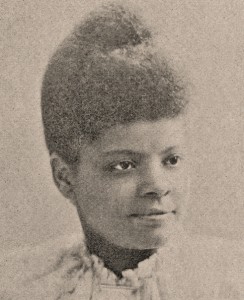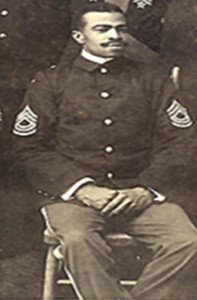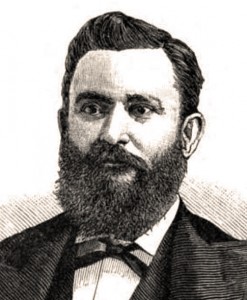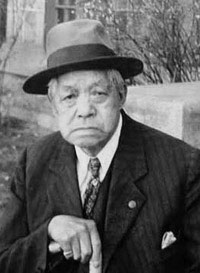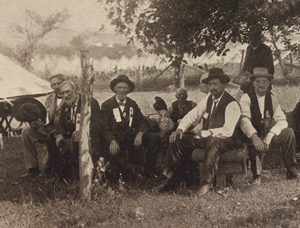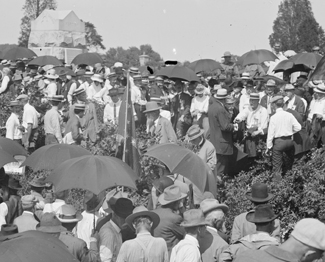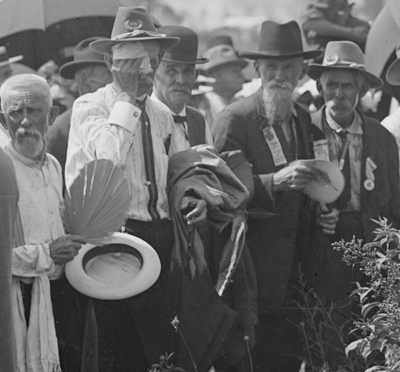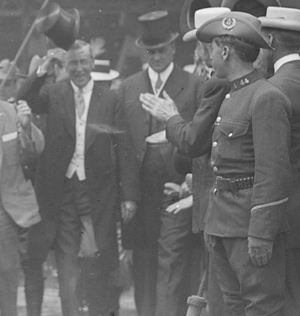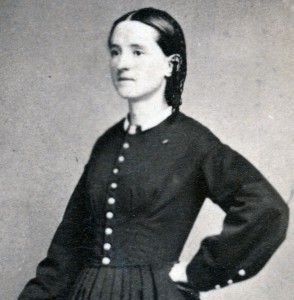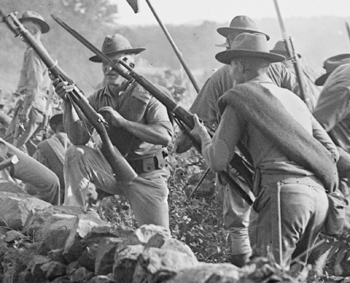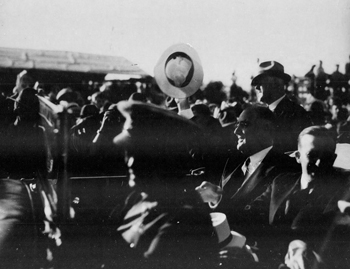This picture from ten volume The Photographic History of the Civil War edited by Francis Miller (1911) highlights an unexpected gathering of former Confederate generals, including Robert E. Lee, and a few former Union generals such as John Geary and Lew Wallace that occurred in White Sulphur Springs, Virginia in August 1869. This was probably the first photograph of a “Blue-Gray” reunion. For full details, consult Miller’s volume 10 (Armies and Leaders) at Google Books, and see especially p. 4.
Category: Memory & Meaning (1865-2015) Page 1 of 2
Life & Family
Her parents died from yellow fever in 1878. Wells married Ferdinand L. Barnett in 1895 and had four children: Charles, Herman, Ida, and Alfreda.
Sources
As part of her campaign against lynching, Wells published several pamphlets, including Southern Horrors: Lynch Law in All Its Phases (1892), The Red Record: Tabulated Statistics and Alleged Causes of Lynching in the United States (1895), and Mob Rule In New Orleans: Robert Charles and His Fight to Death, the Story of His Life, Burning Human Beings Alive, Other Lynching Statistics (1900). The Ida B. Wells Papers are at the Joseph Regenstein Library, University of Chicago. Other important primary sources include Trudier Harris’ Selected Works of Ida B. Wells-Barnett (1991) and Miriam DeCosta-Willis’ The Memphis Diary of Ida B. Wells (1995). Her daughter, Alfreda M. Duster, published Her Crusade for Justice: The Autobiography of Ida B. Wells in 1970. Important secondary sources include Linda O. McMurry’s To Keep the Waters Troubled: The Life of Ida B. Wells (1998) and James West Davidson’s ‘They say’: Ida B. Wells and the Reconstruction of Race (2007).
Places to Visit
A historical marker is located on Beale Street in Memphis, Tennessee. This marker honors Wells’ work as editor of the Memphis Free Speech. After her paper published reports about the lynching of three African-American businessmen in 1892, her newspaper’s office was destroyed.
Images
While the Library of Congress Prints and Photographs Division has several images, only one is available for download at a high resolution. The New York Public Library Digital Gallery also has several images.
Life & Family
Sgt. Presley (also Pressley or Presly) Holliday, USA
(1873-1954)
Steelton High School (Class of 1890), Married Estelle M. Hill
Buried in Midland Cemetery
Sources
Key primary sources include the following letters:
Presley Holliday’s letter to the editor of the New York Age, April 22, 1899 (response to Theodore Roosevelt)
Presly Holliday to George Myers June 8, 1901
“Reply To Mr. Lainer,” Washington (DC) Post, May 1, 1935, p. 8: 4-5.
“The Utterback Case,” Washington (DC) Post, May 7, 1935, p. 8: 6.
“Are Ethiopians Negroes?,” Washington (DC) Post, September 11, 1935, p. 6: 4-5.
“Thinks Fighting Men Should Be Upheld In Fight Against Unfairness,” Pittsburg (PA) Courier, June 12, 1943, p. 22: 6.
“Cites Faults of a Mixed Army,” Pittsburg (PA) Courier, September 27, 1947, p. 6: 4.
“Racial Mixtures,” Washington (DC) Post , December 28, 1949, p. 10: 4-5.
Holliday to President Harry Truman, September 4, 1945
While none of Holliday’s letters from the Eisenhower Administration appear to be online, see this finding aid and use the CTRL + F to search “0126 124-A-1” and find the section that lists Holliday as a “Principal Correspondents.”
Places to Visit
Presly Holliday wrote letters to several United States Presidents. While in Washington DC you can visit the White House.
Sources
Important primary sources include Oates’ perspective on the Civil War in “Gettysburg: The Battle on the Right,” Southern Historical Society Papers 6 (1878) and The War Between the Union and the Confederacy (1905). Oates also published articles on a variety of other topics, such as “The Homestead Strike, A Congressional View,” North American Review 155 (1892) and “Industrial Development of the South,” North American Review 161 (1895). In addition, the Gettysburg National Military Park has the letters in which Union Col. Joshua Chamberlain and Oates discussed whether a monument for the Fifteenth Alabama should be built on Little Round Top. As for Oates’ “private papers,” his profile on American National Biography notes that a descendant owns them. Key secondary sources include Glenn LaFantasie, ed., Gettysburg: Colonel William C. Oates and Lieutenant Frank A. Haskell (1992) and Gettysburg Requiem: The Life and Lost Causes of Confederate Colonel William C. Oates (2006). You can also read LaFantasie’s article “The Inimitable William C. Oates” online at Gettysburg National Military Park’s website. Also see Mark Perry’s Conceived in Liberty: Joshua Chamberlain, William Oates, and the American Civil War (1997). As for information on the Fifteenth Alabama, see the Alabama Department of Archives & History’s Brief Historical Sketches of Military Organizations Raised In Alabama During the Civil War.
Places to Visit
You can visit Little Round Top at the Gettysburg National Military Park. While in Gettysburg you can also tour the David Wills’ house and see the bedroom where Lincoln stayed the night before he delivered the Gettysburg Address in November 1863.
Artifacts
The 15th Alabama Infantry flag is in the Alabama Civil War Period Flag Collection at the Alabama Department of Archives & History. In addition, the Gettysburg National Military Park has a number of artifacts related to the battle, including this haversack and a Confederate enlisted man’s uniform.
Images
Several images are on Oates’ House Divided profile. In addition, the Alabama Department of Archives and History posted several photographs of Oates on his profile at the Encyclopedia of Alabama.
The slideshow below includes images related to the Battle of Gettysburg.
Narrative
Edward Day Cohota was a young Chinese immigrant who lied about his age to be able to enlist in the Union army in 1864. He served with honor in the 23d Massachusetts (Army of the Potomac) during some of the war’s bloodiest campaigns in Virginia. He was present at the Battle of Cold Harbor in June 1864 and helped save the life of a fellow soldier named Low who never forgot Cohota’s bravery. Yet some Americans did forget the contributions of Chinese. In 1882, Congress passed the first Chinese Exclusion Act. The anti-Chinese legislation did not affect Cohota, however, until 1912 when he was denied an application for a homestead on the grounds that he was not a legitimate citizen. The insult infuriated the veteran.
“I have fought in the country’s service as a soldier…I believe that I, if anyone, have earned the right to be pronounced a citizen of the United States and enjoy all of its rights and privileges…I respectfully ask that some action be taken that will enable me to become a citizen of the United States of America.”
Cohota died in 1935 still stripped of his US citizenship. Congress did not repeal the Chinese Exclusion rules until World War II.
Sources
This short report from the New York Times on November 13, 1927 notes that Cohota had “spent thirty years in the service” and “[was] spending his last days at the Battle Mountain Sanitarium” in Hot Springs, South Dakota. One important secondary source is Ruthanne Lum McCunn’s article: “Chinese In the Civil War: Ten Who Served,” Chinese America: History and Perspectives 10 (1996): 149-169. In addition, the US Army has a profile of Cohota on this page.
Places to Visit
No structures or sites related to Cohota exist. Cohota grew up abroad Captain Sargent S. Day’s ship as well as the Day family home in Gloucester, Massachusetts. After Confederates surrendered in 1865, Cohota was stationed at Fort Randall, Dakota Territory. In 1935 Cohota died at the Battle Mountain Sanitarium for Veterans in Hot Springs, South Dakota.
Images
The US Army has a photograph of Cohota on this page.
Sources
Shepherd wrote several books, including The History of the English Language from the Teutonic Invasion of Britain to the close of the Georgian Era (1874),
Life of Robert Edward Lee (1906), and Narrative of Prison Life at Baltimore and Johnson’s Island, Ohio (1917). In addition, Documenting the American South has a short essay about Shepherd.
Places to Visit
Shepherd served in the 43rd North Carolina Infantry Regiment and was captured during the Battle of Gettysburg. The 43rd North Carolina’s monument at Gettysburg is located on East Confederate Avenue. While in Gettysburg you can also visit the Gettysburg National Military Park Museum and Visitor Center as well as tour the David Wills’ house.
Images
A photograph of Shepherd is available on his House Divided profile.
These are just some of the pictures that were published in the Fiftieth Anniversary of the Battle of Gettysburg: Report of the Pennsylvania Commission December 31, 1913 (Harrisburg: Wm. Stanley Ray, 1915). See Pennsylvania Guests 1 for a picture of granddaughters of General Meade and General Hill. Pennsylvania Guests 2 is a picture of General Longstreet’s son, Grandsons of General Longstreet, and Grandsons of General Pickett.
“Pennsylvania Guests 1” — Click on link to see full image.
“Pennsylvania Guests 2” — Click on link to see full image.
Vermont’s Monument to Her First Cavalry and Major General Wells at Gettysburg. Dedicatory Services, July 3, 1913 — Click on link to see full image.
Image Credit – Dickinson College Archives and Special Collections; House Divided Project
Click on the Image to the right for a larger version.
“The reunion at “Bloody Angle” – Pickett’s men in for[e]ground; Union men lined against wall. Photo shows the Gettysburg Reunion (the Great Reunion) of July 1913, which commemorated the 50th anniversary of the Battle of Gettysburg. ” – Text from Library of Congress Metadata
Posted by Don Sailer
Image Credit – George Grantham Bain Collection, Library of Congress Prints and Photographs Division
Click on the Image to the right for a larger version.
“Photo shows the Gettysburg Reunion (the Great Reunion) of July 1913, which commemorated the 50th anniversary of the Battle of Gettysburg ” – Text from Library of Congress Metadata
Posted by Don Sailer
Image Credit – George Grantham Bain Collection, Library of Congress Prints and Photographs Division
Click on the Image to the right for a larger version.
Read President Wilson’s speech at Gettysburg (on July 4, 1913) here.
Posted by Don Sailer
Image Credit – George Grantham Bain Collection, Library of Congress Prints and Photographs Division
Speech Credit – : John T. Woolley and Gerhard Peters, The American Presidency Project [online]. Santa Barbara, CA. Available from World Wide Web: http://www.presidency.ucsb.edu/ws/?pid=65370
Life & Family
President Andrew Johnson signed bill that authorized Medal of Honor for Walker. President Carter restored Walker’s Medal of Honor on June 10, 1977.
Sources
While Walker published two books – Hit: Essays on Women’s Rights (1871) and Unmasked, or the Science of Immorality, To Gentlemen by a Woman Physician (1878) – , she never wrote about her experiences as a surgeon during the Civil War. In addition, the Mary Edwards Walker Papers at Syracuse University contain her correspondence. Several books about Walker have recently been published, including Dale L. Walker’s Mary Edwards Walker: Above and Beyond (2005), Sharon M. Harris’ Dr. Mary Walker: An American Radical, 1832-1919 (2009), and Bonnie Z. Goldsmith’s Dr. Mary Edwards Walker: Civil War Surgeon & Medal of Honor Recipient (2010). Other important secondary sources include Elizabeth D. Leonard’s Yankee Women: Gender Battles in the Civil War (1994). In addition, see entries in Judith E. Harper’s Women During the Civil War: An Encyclopedia (2007) and Lynne E. Ford’s Encyclopedia of Women and American Politics (2008). You can also read Walker’s profile at the “National Library of Medicine.” In addition, this article from the New York Times on June 4, 1977 describes the efforts to restore her Medal of Honor.
Artifacts
Walker’s original Medal of Honor is apparently at the Oswego County Historical Society in New York.
Images
Several images are in the Library of Congress Prints & Photographs Collection , including one circa 1860-70 and one circa 1911. The Mary Edwards Walker Papers at Syracuse University also contain several photographs.
Click on the Image to the right for a larger version.
Image Caption – “Seventy-Fifth Anniversary Of Battle Of Gettysburg, PA”
Speech Credit – John T. Woolley and Gerhard Peters, The American Presidency Project [online]. Santa Barbara, CA. Available from World Wide Web: http://www.presidency.ucsb.edu/ws/?pid=15669
Click on links below for more pictures –
http://housedivided.dickinson.edu/ncc/images/FDR_2.jpg
http://housedivided.dickinson.edu/ncc/images/FDR_3.jpg
http://housedivided.dickinson.edu/ncc/images/FDR_4.jpg
Also, click here to read FDR’s speech (July 3, 1938)
Posted by Don Sailer
Image Credits – NARA M865 (Selected Photographs of Franklin D. Roosevelt, 1913-1945); Footnote.com
